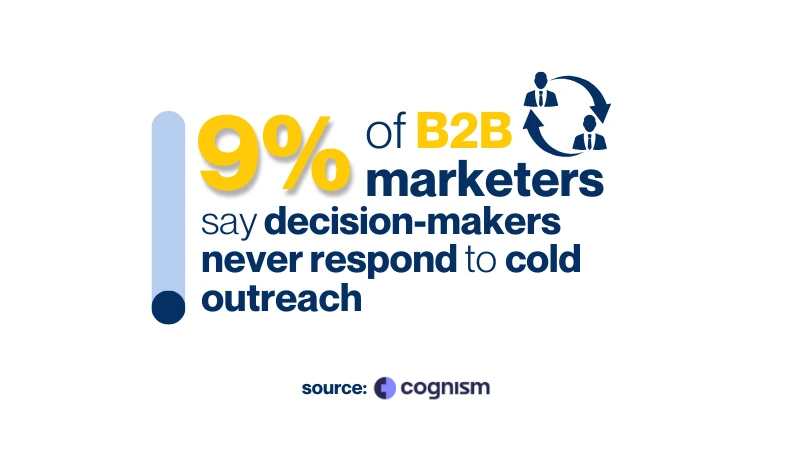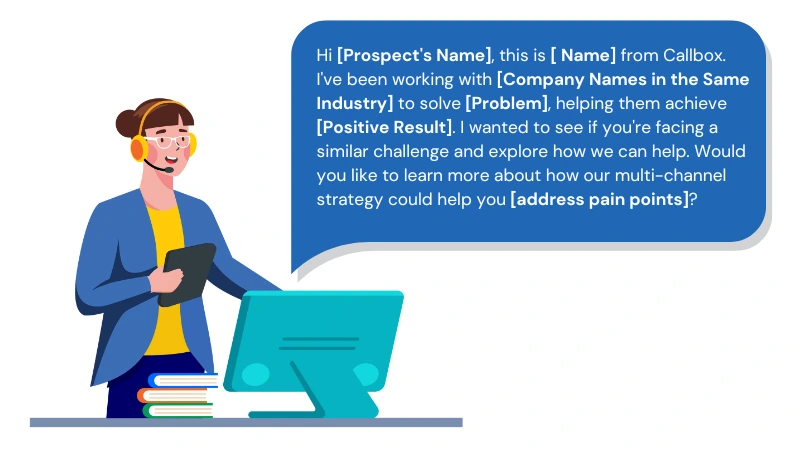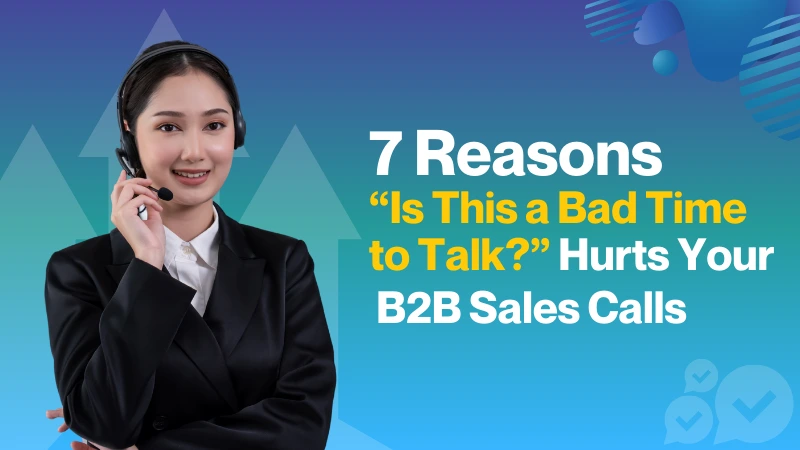You only have three seconds to grab the prospect’s attention. A strong opening can build trust and increase your chances of closing a deal, while a weak one can cost you valuable opportunities.
Many businesses think the first impression happens when sales reach out, but it starts earlier when prospects visit your website, see your contact form format, or through automated follow-ups.
Slow website speeds, confusing forms, or delayed, generic responses can turn prospects off before they engage. The key to success is ensuring that every interaction is smooth and welcoming.

Timing is just as important when it comes to reaching decision-makers. Just because they answer the phone doesn’t mean they’re available to talk. Avoid asking “Is this a bad time to talk?”, because it shows negativity and suggests you’re about to waste their time. The study shows that this phrase reduces meeting appointments by 40%.
Here’s why this question could be costing you deals.
7 Reasons Why Sales Reps Should Never Ask The Question
This common question wastes valuable opportunities and can backfire. Here’s why:

- It States the Obvious – When you call a prospect, you’re borrowing their time, and it’s clear that sales calls are often interrupted. Asking if it’s a bad time is not only redundant but can also be irritating. Despite effective cold outreach, only 9% of B2B marketers say decision-makers never respond. Instead, get straight to the point with confidence and respect their time.
- Draws Attention to Their Workload—By asking, you make the prospect focus on their busy schedule, prompting them to decline. This may refer to explicit or automatic memory. When someone is reminded of their workload, they instinctively reject additional commitments.
- Sounds Like Every Other Sales Call—Starting with this question makes you sound like every other salesperson, prompting the prospect to disengage. Research shows that personalized calls convert 202% better than generic outreach, so starting with a tailored multi-touch, multi-channel approach is crucial.
- It Wastes a Valuable Opportunity – If prospects pick up, they’re open to a conversation. Asking if it’s a bad time only creates an unnecessary obstacle. Truly busy prospects won’t answer, but if they do, they have a brief time. Statistics show that 70% of buyers accept cold calls and 80% take calls from past providers. Be direct and show that you value their time by getting straight to the point.
- Triggers a Defensive Response –57% of top executives prefer phone contact, but remember, you’re not the only one calling, they get many calls daily. Asking if it’s a bad time makes them feel the need to protect their time, leading to a quick hang-up. Instead, get to the point and offer value right away.
- Signals Uncertainty and Weakens Authority – Asking for permission to continue shows uncertainty, which can turn buyers away. It makes you seem intimidated, unsure, and afraid of rejection. Don’t fear rejection, it takes an average of three cold call attempts to connect with a lead. Stay confident and keep going.
- Follow Predictable Patterns– Buyers are conditioned to expect it and will likely shut it down quickly. Reports reveal that only 31% of calls progress beyond the pitch. Sales trainer Jeff Hoffman highlights the importance of disrupting the buyer’s flow, emphasizing the need to avoid generic questions and capture their interest immediately.
What to Say Instead
The traditional cold calling structure—Intro, Power Statement, Bridge, and Ask—may not be as effective in Australia, especially when engaging C-suite executives. Australian business culture places a strong emphasis on politeness and a consultative approach, where prospects prefer to give permission for the conversation rather than feeling pressured.
1. Acknowledge their Limited Time
Instead of asking if it’s a bad time, acknowledge their busy schedule without emphasizing it

Example:
” Hi, This is [Name] from Callbox. I wanted to share how we helped [Similar Company] reduce costs by [Specific Benefit]. Can I take 30 seconds to tell you more?”
This approach shows respect for their time while immediately highlighting the value you bring.
2. Be Direct and Concise
Rather than asking if it’s a good time, skip the question and get straight to the point.
Example:
” Hi [Prospect’s Name], [Name] from Callbox, I listened to your Q4 earnings call and noticed your goal of achieving 8% topline sales growth while maintaining 25% margins this fiscal year.
I’m currently working with sales teams at [Companies in the Same Industry] to help them exceed their sales targets.
I’d love to explore how we might do the same for your team. Would Thursday at 3 PM work for a quick conversation?”
By showing that you’ve done your research, you change the focus from their busy schedule to how you can help them.
3. Avoid Generic Sales Pitches
Many salespeople use the same tired questions, so avoid the standard introductions.

Example:
“Hi [Prospect’s Name], this is [Name] from Callbox. I sent you an email last Wednesday—did you get a chance to look at it?”
[Personalize based on their response]
“I reached out because I saw you’re leading [Specific Role] at [Company]. Is that correct?
Would it be all right if I took 30 seconds to explain?
This acknowledges the interruption but immediately shifts to something beneficial, setting a confident tone.
4. Don’t Waste the Opportunity
If they answered the phone, they were open to a conversation. Don’t waste that moment with unnecessary questions.
Example:
“Hi [Prospect’s Name], this is [ Name] from Callbox. We help businesses like yours [Specific Benefit] and would love to share how we can deliver similar results for you. Are you available for a quick call next week?”
By immediately providing relevant value, you make it harder for them to disengage.
5. Keep the Focus on Value
Rather than giving them the option to protect their time, make the conversation about the value you provide.

Example:
“Hi [Prospect’s Name], this is [ Name] from Callbox. I’ve been working with [Company Names in the Same Industry] to solve [Problem], helping them achieve [Positive Result]. I wanted to see if you’re facing a similar challenge and explore how we can help. Would you like to learn more about how our multi-channel strategy could help you [address pain points]?”
This approach confidently moves past the hesitation and invites them to engage on your terms.
6. Speak with Purpose and Professionalism
Rather than seeking permission, frame your message as a solution that’s worth their time.
Example:
Hi [Prospect’s Name], I understand that [Prospect’s Company] is aiming to [Specific Goal], and achieving this efficiently is crucial. Our solution has helped companies like [Similar Company] accomplish [Specific Achievement], and I believe we can do the same for you.
Could we schedule a brief call to discuss how we can support your objectives?
This positions your call as a strategic conversation rather than an interruption.
7. Present Your Offer in a Compelling Way
If you do want to acknowledge their busy schedule, do so in a way that sparks curiosity.

Example:
“Hi [Prospect’s Name], this is [Your Name] from Callbox. I’m reaching out because we noticed [Competitor] has [Accomplishment], and we can help you achieve even better results with a more precise multi-channel strategy. I’d love to share how—do you have a moment?”This approach uses industry insights and competitive awareness to create intrigue, making it harder for them to dismiss your call.
Win Sales Conversions with the Right Approach
Weak openings can cost you valuable opportunities by making you sound uncertain or overly salesy, causing prospects to disengage. Phrases like “I know you’re busy” may seem polite but signal hesitation, making it easier for the prospect to brush you off. Instead, confident and value-driven openings immediately capture interest and set the stage for meaningful conversations.
Prospects are more likely to stay engaged when you present yourself as a problem-solver rather than just another salesperson. By leading with clear value and a strong presence, you increase your chances of converting cold calls into real business opportunities.
Callbox refines B2B lead generation sales approaches with expertly crafted outreach strategies that maximize engagement and conversions. Through multi-channel lead generation, we ensure connections with key decision-makers, leveraging a mix of personalized emails, strategic cold calls, and targeted social outreach.
Our proven sales call frameworks help businesses confidently open conversations, focusing on value-driven messaging that keeps prospects engaged. Australian businesses have trusted us as a lead generation services provider since 2004. We help B2B companies generate high-quality leads, speed up sales cycles, and foster customer relationships that drive real business.
Boost your B2B sales with Callbox. Connect with key decision-makers and accelerate growth. Book a consultation today.













